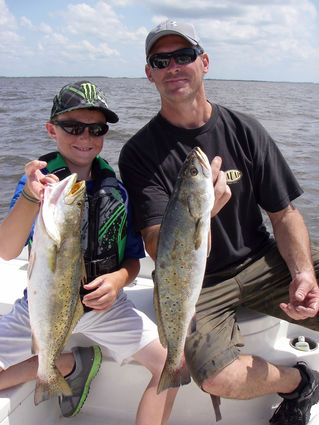A cork for all seasons
Last updated 6/6/2012 at Noon
“I didn’t drive over here to fish with no danged cork,” barked Matt Lenz as he watched both his Father and brother arch their Kwik Cork rigs over several rows of modest white caps. “I don’t care if y’all catch the biggest trout we ever saw, I ain’t fishing with no cork!”
Two hours later, fishing a slow bite at best, Dad had still put four solid trout in the box and Matt’s more compliant older sibling had nine. In spite of their hard earned success, Matt would not waver on his declaration and had added only a croaker to the catch just to save face.
Convinced that the wind was not going to give us a break, I cranked up and turned southward in hopes of finding a few birds working over schooling trout or reds. Three gulls sitting on the water were reason enough to shut down the big engine and make a few exploratory casts. I was tying on a Hoginar on the chance that we might have found some redfish when both Kwik Corks immediately dipped below the surface.
Before I could net their fish, shrimp started dancing across the surface in a futile attempt to make it back to the safety of the mud covered bottom. Even Matt was in the hunt with his Skitterwalk this time and he quickly boxed three very nice trout. While he felt a little better about having caught fish as he put it, “like a real man” he wasn’t all smiles when the bite finally ended.
Before running more lake, I counted 28 trout and Matt’s croaker in the box. All but three of the fish on ice had fallen victim to a tail fished under a cork and that fact wasn’t lost on Matt. “I thought they’d have to take those corks off if we ever found school fish, but they didn’t miss a lick,” he begrudgingly pointed out to the rest of the family.
I worked the Daley’s Hunt N Fish annual fishing show for two days last week and aside from continuous teasing about my yellow ZEKO shoes, the lion’s share of my one on one conversations were in regards to scraping the wall with a maniac mullet in the winter and fishing a Kwik Cork rig.
The ultimate value of fishing plastic or even live bait under a cork is that it keeps your bait in the strike zone 100 percent of the time. Add to that the fact that the chugging or clicking noise the rig makes attracts fish and you have significantly upgraded your chances of at least getting a strike.
Both of those qualities also make it an excellent choice for hunting fish when there are no signs of them even being in the area. That recent trip was a perfect example as the first bunch of trout we boxed were the result of simply drifting over a shallow flat that held fish the day before.
The ultimate bonus lies in the fact that you do not have to cut the rig off and tie on another lure should you encounter schooling fish or fish driving bait to the surface. Surprisingly enough, more often than not, the color of the plastic is not as critical a factor when fished under a cork in schooling fish. That is not the case when making random casts and trying to establish a pattern, but there is seldom any need to swap colors when dealing with schooling fish.
There are those rare occasions when a three to four foot leader produces far more strikes, but for the most part we stick with something in the 24 to 30 inch range. The shorter leader is also much easier to cast longer distances. I personally prefer the sound of the cup shaped cork, but the oval style is much easier to fish as there is less resistance when setting the hook and fighting the fish.
I fish only corks with a titanium wire as it will not permanently bend or crimp and ruin the entire rig. The first change I make is to melt a short piece of electrical connection tubing over all but the top eye on the swivel on top of the cork so that it doesn’t flop around and allow my line to wrap around the cork when it is at rest. That improvement alone eliminates wasted casts.
Secondly, I add a split ring and ¼ ounce trolling sinker to the swivel at the bottom end of the cork. That gives you enough weight to throw even the lightest of tails a long way. It also gives you the ability to fish a Texas rigged tail with no weight at all and that can make a big difference when targeting big trout!
Spinning rods work much better for me than casting rods and I prefer 20-pound braid over mono for its sensitivity and lack of stretch. My leader material below the cork is usually 20-pound mono.
I will catch more fish from now through December with this rig than anything else I will fish and I will fish everything from topwaters to Swim Baits. This technique is not the end all-be all, but it will keep you in the hunt on the toughest of days and that is good enough for me!














Reader Comments(0)